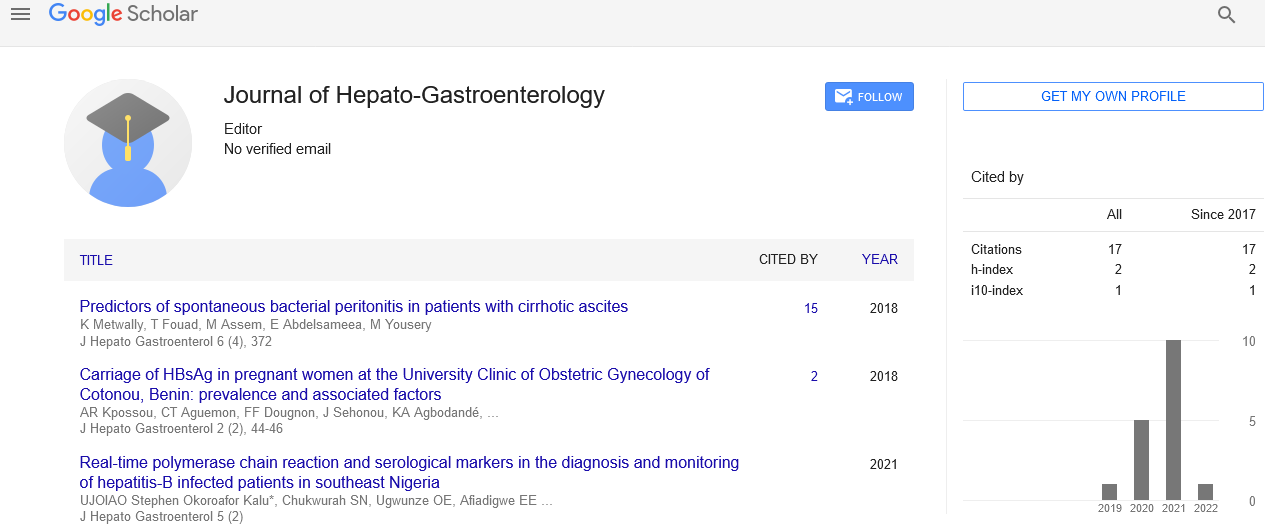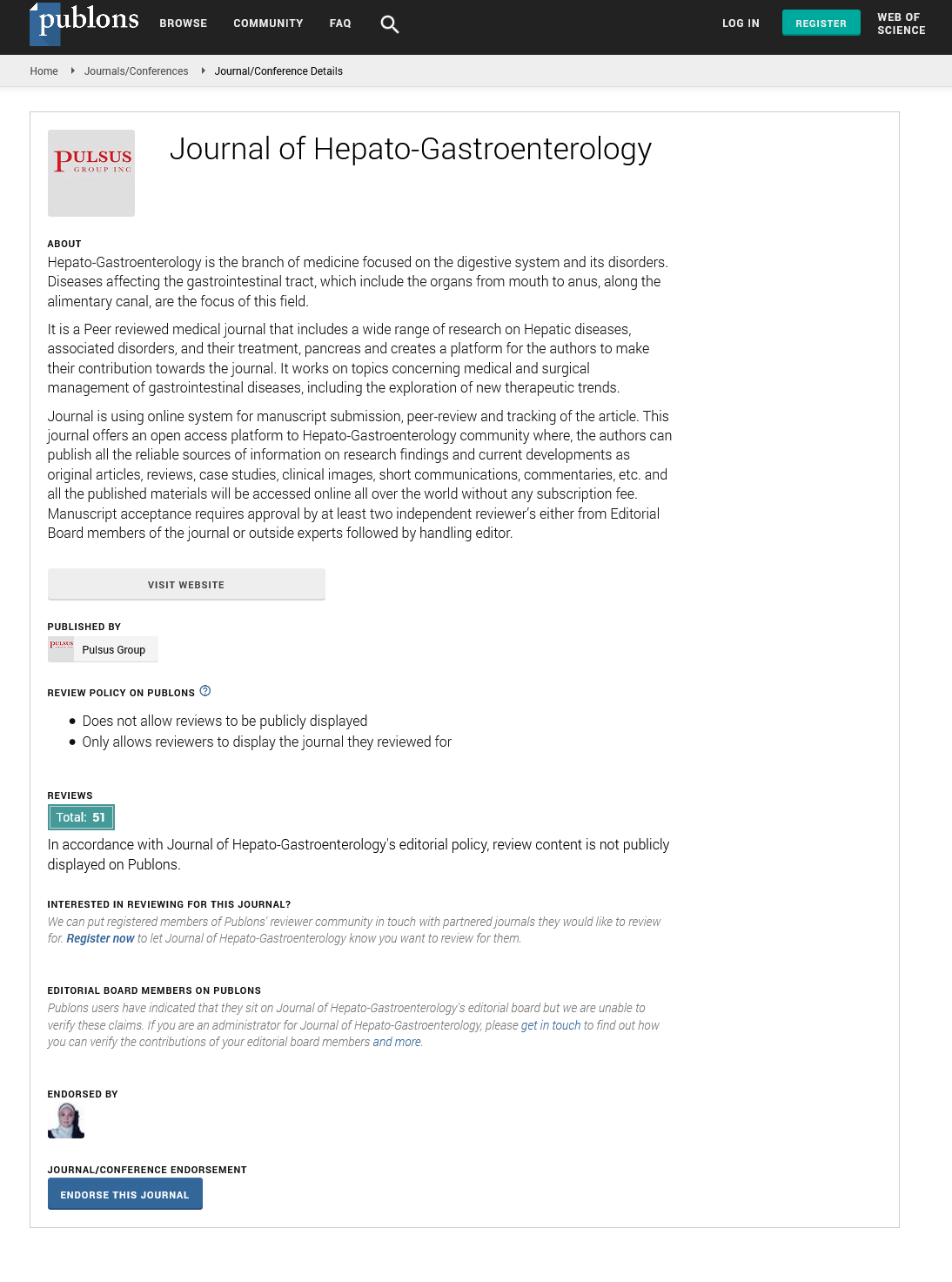Pancreatic fluid collections and pseudocyst treatment
Received: 03-Jan-2022, Manuscript No. PULHG-22-4265; Editor assigned: 10-Jan-2022, Pre QC No. PULHG-22-4265 (PQ); Accepted Date: Jan 06, 2022; Reviewed: 17-Jan-2022 QC No. PULHG-22-4265; , Manuscript No. PULHG-22-4265 (R); Published: 26-Jan-2022, DOI: 10.37532/ pulhg.6.1.1
Citation: Bernal R. Pancreatic fluid collections and pseudocyst treatment. J Hepato Gastroenterol. 2022;6(1):1.
This open-access article is distributed under the terms of the Creative Commons Attribution Non-Commercial License (CC BY-NC) (http://creativecommons.org/licenses/by-nc/4.0/), which permits reuse, distribution and reproduction of the article, provided that the original work is properly cited and the reuse is restricted to noncommercial purposes. For commercial reuse, contact reprints@pulsus.com
Abstract
Acute Necrotic Pancreatitis (ANP) stays a muddled issue of pressing a medical procedure in view of high recurrence of fundamental, purulent, and septic confusions, death rate, which is in patients with tainted pancreonecrosis 14.7%-26.4%. Treatment comprises forceful intravenous liquid revival, torment control, and organization of enteral sustenance as soon as could really be expected. While sterile corruption may resolve with the above moderate measures, contaminated rot requires further intercession.
Key Words
Pancreatitis; Intravenous; Intercession
Introduction
Pancreatic Fluid Collections (PFCs) are a continuous entanglement of pancreatitis. It is essential to arrange PFCs to direct administration. The overhauled Atlanta standardarrangees PFCs as intense or ongoing, with constant liquid assortments, partitioned into pseudocysts and Walled-Off Pancreatic Necrosis (WOPN). Laying out satisfactory healthful help is a fundamental stage in the administration of PFCs. Early endeavors at oral taking care can be tested in patients with gentle pancreatitis. Enteral taking care of should be executed in patients with moderate to serious pancreatitis. Jejunal taking care of stays the favored course of enteral sustenance.
TYPES OF PANCREATIC FLUID
Accurately arranging Pulmonary Circulation PFCs is basic for streamlining treatment and the executives. The principal inescapable characterization framework was created in 1993 by a global agreement meeting in Atlanta, Georgia, and became alluded to as the Atlanta Criteria. These rules grouped pancreatic liquid assortments as intense or constant assortments, with persistent assortments being additionally partitioned into pancreatic rot, pseudocysts, and pancreatic abscesses.
Nonetheless, with improving pathophysiologic understanding and working on analytic devices, obviously, a more nitty-gritty authoritative framework was required. All the more explicitly, one that recognized assortments containing liquid alone versus those emerging from putrefaction as well as containing strong parts. All things considered, another arrangement framework was created known as the amended Atlanta models The motivation behind this study is to assess productivity and layout signs for negligibly obtrusive techniques for treatment of post-necrotic pseudocyst of the pancreas. Strategy and Hypothetical Orientation: For diagnostics ultrasonography was utilized, symptomatic laparoscopy, helical CT with contrast fortifying. Endoscopic mediations were applied by duodenoscopes “Olympus” taken care of X-beam machine “Siemens BV 300”. Cystodigestive fistulas were made by thorny papillotomy. For giving of long tolerability of cystodigestive fistula were utilized two endoprostheses like “ponytail” measured 10 Ft with length 5-6 cm. For transpapillary waste were utilized pancreatic endoprostheses like “ponytail”, measured 5-7 Ft with a length of 5 cm. In 82 (68.2%) patients have applied negligibly obtrusive strategies for treatment; Percutaneous outer waste in 38 (46.3%) patients, endoscopic transmural waste of postnecrotic pseudocyst in 22 (26.85%) patients. Joined endoscopic intercessions were applied in 22 (26.85%) patients. Specifically, endoscopic transmural seepage with transitory stenting of pancreatic conduit in 11 (half) patients, endobiliary stenting with brief stenting of pancreatic channel in 5 (22.7%) patients, brief stenting of the pancreatic channel in 4 (18.2%) patients, endoscopic transmural waste with percutaneous outer waste in 2 (9.1%) patient. End and Significance: Usage of joined negligibly obtrusive techniques for treatment of intense necrotic pancreatitis muddled by post-necrotic pseudocyst help to further develop aftereffects of treatment, a decrease of complexities sum, withdrawal of fixed treatment terms, and improving life quality.
Conclusion
Pancreatitis can habitually bring about the advancement of liquid assortments, going from basic pseudocysts to WOPN. The underlying advance in administration of these assortments is guaranteeing satisfactory healthful help is given. Enteral nourishment is liked over parenteral sustenance, with post-pancreatic jejunal taking care of being the ideal enteral course in patients with a moderate or serious infection. Suggestive PFCs require seepage. Endoscopic waste can be effectively achieved with further developed wellbeing and adequacy when contrasted with careful or radiologic approaches. Moreover, patients with Walled-Off Pancreatic Necrosis (WOPN) can securely go through endoscopic necrosectomy, blocking the requirement for careful investigation. In conclusion, in all patients with suspected PD interruption, Endoscopic Retrograde Cholangio Pancreatography (ERCP) with PD investigation ought to be performed, and assuming MRCP is accessible, it ought to be involved as needs be to preclude pancreatic channel disturbance in low likelihood patients.






